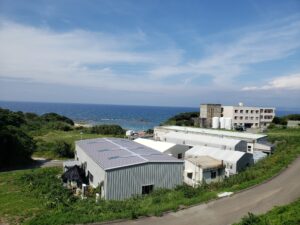The Field Science Center of Tokyo University of Marine Science and Technology consists of the Tateyama Station, Tateyama Bay Branch, Tomiura Station, Shimizu Station, and the Oizumi Station and Yoshida Station. Here the Tateyama Station, the center of the waterfront facilities, is introduced. For other stations, please see the website below.
Tateyama Station was established in Takashima, Tateyama City, Chiba Prefecture in 1909, moved to Kominato, Chiba Prefecture in 1932, and then relocated again to Banda, Tateyama City in 1984, where it remains today. The staff consists of two associate professors, one technical specialist, and one part-time employee.
Up to 200 tons of seawater per hour is pumped to supply tanks of various sizes, making it possible to raise a wide variety of fish, including eastern little tuna, chub mackerel, and Japanese horse mackerel. Using those fish, research is being vigorously carried out to develop new aquacultured fish through “surrogate broodstock technology”. Studies of the behavioral ecology of fish have been conducted through diving observations, and studies of marine organisms such as invertebrates and algae have also been conducted. Oceanographic research is conducted by two vessels, the Sagitta VI (5 tons, 14 people) and the Sagitta VII (0.7 tons, 6 people).
The dormitory building can accommodate approximately 80 people. In addition to on-campus training, the station hosts off-campus training and tours for elementary and junior high schools, universities, and the public. A total of more than 10,000 people visit the station annually.

Tateyama Station, The Field Science Center, Tokyo University of Marine Science and Technology
670 Banda, Tateyama City, Chiba 394-0308, Japan
Phone: +81 (470) 29-1144
E-mail: tmorit0@kaiyodai.ac.jp
HP: https://www.kaiyodai.ac.jp/Japanese/academics/center/index-e.html
